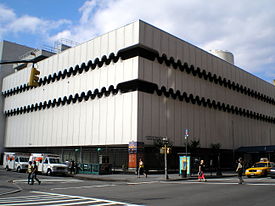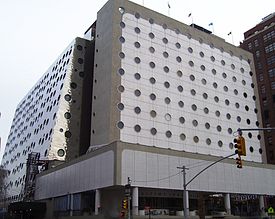- National Maritime Union
-
National Maritime Union Founded May 1937 Merged Seafarers International Union of North America (June 3, 2001) Country United States Affiliation Congress of Industrial Organizations, later AFL-CIO Office location New York City, New York The National Maritime Union (NMU) was an American labor union founded in May 1937. It affiliated with the Congress of Industrial Organizations (CIO) in July 1937. After a failed merger in 1988, the union merged with the Seafarers International Union of North America in 2001.
Contents
Early years
The NMU was founded in 1936 by Joseph Curran, who was at the time an able seaman and boatswain aboard the ocean liner S.S. California. Although he was a member of the International Seamen's Union (ISU), he was not active in union activities.
From March 1 to March 4, 1936, Curran led a strike aboard the Panama Pacific Line's S.S. California, then docked in San Pedro, California. Curran and the crew of the California went on what was essentially a sitdown strike[1] at sailing time, refusing to cast off the lines unless wages were increased and overtime paid.[2][3][4]
United States Secretary of Labor Frances Perkins personally intervened to resolve the strike. Speaking to the crew by telephone, Perkins agreed to arrange a grievance hearing once the ship docked at its destination in New York City, and that there would be no reprisals by the company or government against Curran and the strikers.[2][3][4]
During the California's return trip, the Panama Pacific Line raised wages by $5 a month to $60 per month.[1] But United States Secretary of Commerce Daniel Roper and the Panama Pacific Line declared Curran and the strikers mutineers. Curran and other top strike leaders were fined two day's pay, fired and blacklisted, but Perkins was able to keep the strikers from being prosecuted for mutiny.[2][3][4]
Seaman all along the East Coast struck to protest the treatment of the California's crew. Curran became a leader of the 10-week strike, eventually forming a supportive association known as the Seamen's Defense Committee. In October 1936, Curran called a second strike, in part to improve working conditions and in part to embarrass the ISU. The four-month strike idled 50,000 seamen and 300 ships along the Atlantic and Gulf coasts.[1][3][5]
Believing it was time to abandon the conservative International Seamen's Union, Curran began to sign up members for a new, rival union. The level of organizing was so intense that hundreds of ships delayed their sailing time as seamen listened to organizers and signed union cards.[6] One of the co-founders of the organization was the later civil-rights activist James Peck.[7]
In May 1937, Curran and other leaders of his Seamen's Defense Committee reconstituted the group as the National Maritime Union. It held its first convention in July, and 30,000 seamen left the ISU to join the NMU. Curran was elected president of the new organization. The black, Jamaican-born Ferdinand Smith was elected as the union's secretary-treasurer.[1][2][3] Within a year, the NMU had more than 50,000 members, and most American shippers were under contract.[1][6]
 This building at Seventh Avenue between 12th Street and 13th Street, designed by Albert C. Ledner, was built in 1964 as the union's headquarters. The hiring halls were in the glass blocks on the ground floor. The union sold it to St. Vincent's Hospital in 1973.[8]
This building at Seventh Avenue between 12th Street and 13th Street, designed by Albert C. Ledner, was built in 1964 as the union's headquarters. The hiring halls were in the glass blocks on the ground floor. The union sold it to St. Vincent's Hospital in 1973.[8]
 The Joseph Curran Annex (left) and Plaza (right), on Ninth Avenue between West 16th and 17th Streets, were built in 1966, also designed by Ledner.[8] The Ninth Avenue building on the right is currently the Maritime Hotel, while the 17th Street building (left) is being converted into the Dream Downtown Hotel.
The Joseph Curran Annex (left) and Plaza (right), on Ninth Avenue between West 16th and 17th Streets, were built in 1966, also designed by Ledner.[8] The Ninth Avenue building on the right is currently the Maritime Hotel, while the 17th Street building (left) is being converted into the Dream Downtown Hotel.
Immediately after the NMU's founding convention in July 1937, Curran and other seamen's union leaders were invited by John L. Lewis to come to Washington, D.C., to form a major organizing drive among ship and port workers. The unions comprising the CIO had been ejected by the American Federation of Labor (AFL) in November 1936, and now Lewis wanted to launch a maritime union. His goal was to create a union as large and influential as the Steel Workers Organizing Committee out of the nation's 300,000 maritime workers. Although Lewis favored Harry Bridges, president of the Pacific Coast District of the International Longshoremen's Association, to lead the new maritime industrial union, the other union leaders balked. Curran agreed to affiliate with the CIO, but refused to let Bridges or anyone else take over his union. His views were reflected among those of the other union leaders, and the CIO's maritime industrial union never got off the ground.[6]
By 1946, the NMU had 46 branches, a staff of 500, and 73,000 members.[5]
Expansion
In 1958 the union decided on an aggressive building program, and hired New Orleans-based architect Albert C. Ledner to design some unique buildings for them, including a headquarters building at Seventh Avenue between 12th Street and 13th Street, completed in 1964, a block-through service annex at 346 West 17th Street and a plaza and "pizza-box"-shaped companion building next to it on Ninth Avenue, both built in 1966 and both named for Joseph Curran.[8] The Curran buildings held offices for the union and its pension fund, medical and training facilities, dormitory rooms for seaman, a gymnasium, swimming pool and 900-seat auditorium.[9][10]
In 1973, with the union's fortunes fading with the decreased activity in the Port of New York, the headquarters building was sold to St. Vincent's Hospital. The 17th Street and Ninth Avenue buildings were sold in 1987 to Covenant House, a drug rehabilitation program, for use as a runaway shelter and educational facility.[8]
Mergers
In 1988, the NMU agreed to merge with the Marine Engineers' Beneficial Association (MEBA) to form District 1, MEBA-NMU. The merger did not last. MEBA members charged that the merger referendum was rigged by MEBA president C. E. "Gene" DeFries. The accusations were serious enough that the United States Department of Justice began an investigation. Union members were even more outraged when they learned DeFries and five other union officers paid themselves more than $2 million in severance payments. During the course of their findings, a group of MEBA members (Led by Alex Shandrowsky, Jesse Calhoon, and Don Keefe) peacefully occupied MEBA's Headquarters in Washington, DC after DeFries refused to disclose information to Union Members. DeFries and others were later indicted for crimes relating to their manipulation of union elections and misuse of union offices. U.S. v DeFries (et al.) became the first successful criminal Racketeer Influenced and Corrupt Organizations Act (RICO) prosecution of the governing body of a labor organization, which resulted in the conviction of 18 officials of MEBA), for RICO, RICO conspiracy, embezzlement, extortion, and mail fraud. NMU disaffiliated from the Marine Engineers in 1993.
Louis Parise was elected the newly independent union's president.
In 1999, the NMU became an autonomous affiliate of the Seafarers International Union of North America, and in 2001 it fully merged with that union.
Presidents
- Joseph Curran, (1937–1973)
- Shannon J. Wall, (1973–1991)
- Unknown, (1991–1993)
- Louis Parise, (1993–2001)
See also
- American Maritime Officers
- Marine Engineers' Beneficial Association
- Sailors' Union of the Pacific
- Seafarers International Union
- United States Merchant Marine
References
- Notes
- ^ a b c d e Schwartz, Brotherhood of the Sea: The Sailors' Union of the Pacific, 1885-1985, 1986.
- ^ a b c d Barbanel, "Joseph Curran, 75, Founder of National Maritime Union," New York Times (August 15, 1981)
- ^ a b c d e Kempton, Part of Our Time: Some Monuments and Ruins of the Thirties, 1998 (1955).
- ^ a b c "Retired Union Boss Joseph Curran Dies," Associated Press, August 14, 1981.
- ^ a b "Politics and Pork Chops," Time, June 17, 1946.
- ^ a b c "C.I.O. Goes to Sea," Time, July 19, 1937.
- ^ Pace, Eric (13 July 1993). "James Peck, 78, Union Organizer Who Promoted Civil Rights Causes". New York Times. http://www.nytimes.com/1993/07/13/obituaries/james-peck-78-union-organizer-who-promoted-civil-rights-causes.html. Retrieved 10 April 2010.
- ^ a b c d Gray, Christopher. "Streetscapes: An Architect’s Flotilla of West Side Buildings ". New York Times (November 25, 2007)
- ^ Kolbert, Elizabeth. "City, Seeking Space for Prisoners, Will Condemn Chelsea Building" New York Times (September 16, 1987)
- ^ "Postings:On West 17th, a Little Bit More of West 17th" New York Times (August 11, 1996)
- Bibliography
- Barbanel, Josh. "Joseph Curran, 75, Founder of National Maritime Union." New York Times. August 15, 1981.
- Butler, John A. Sailing on Friday: The Perilous Voyage of America's Merchant Marine. Washington, D.C.: Potomac Books, 1997. ISBN 1574881248
- "C.I.O. Goes to Sea." Time. July 19, 1937.
- Goldberg, Joseph P. The Maritime Story: A Study in Labor-Management Relations. Cambridge, Mass.: Harvard University Press, 1958.
- Herbert, Brian. The Forgotten Heroes: The Heroic Story of the United States Merchant Marine. New York: Forge Books, 2004. ISBN 0765307065
- Horne, Gerald. Red Seas: Ferdinand Smith and Radical Black Sailors in the United States and Jamaica. New York: New York University Press, 2005. ISBN 0814736688
- Kempton, Murray. Part of Our Time: Some Monuments and Ruins of the Thirties. Hardcover reprint ed. New York: Random House, 1998. (Originally published in 1955.) ISBN 0679603107
- "Maritime Union Officials Convicted on Racketeering Charges." Press release. U.S. Dept. of Justice. July 6, 1995. Accessed February 14, 2007.
- "Politics and Pork Chops." Time. June 17, 1946.
- "Retired Union Boss Joseph Curran Dies." Associated Press. August 14, 1981.
- Schwartz, Stephen. Brotherhood of the Sea: The Sailors' Union of the Pacific, 1885-1985. New York: Transaction Publishers, 1986. ISBN 0887381219
- Shorrock, Tim. "Labor Leaders Dissolve Merger of MEBA, NMU." Journal of Commerce. June 8, 1993.
- Shorrock, Tim. "Two Former MEBA Leaders Indicted." Journal of Commerce. July 1, 1993.
- "SIU-A&G and NMU Set Merger Vote." West Coast Sailors. April 20, 2001.
External links
Categories:- AFL–CIO
- Trade unions in the United States
- Maritime history of the United States
- Maritime trade unions
- Organizations established in 1937
- Organizations disestablished in 2001
Wikimedia Foundation. 2010.

